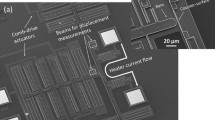Abstract
Stiction is a serious problem in microelectromechanical systems (MEMS) due to their large surface area-to-volume ratio. Stiction is closely related to surface forces, which greatly depend on the materials used, surface topography and surface treatment process. In this paper, we investigate surface energies and stiction of commonly used MEMS materials by contact angle measurements and atomic force microscopy (AFM). Dispersive and polar components of surface energies are calculated by Owens–Wendt–Rabel–Kaelble method. Silicon and silicon-related materials have higher polar surface energies than SU-8 and poly-methylmethacrylate (PMMA), thereby have larger surface energies and enhanced tendency for stiction. The nano-scale adhesion forces between Si3N4 tip and surfaces obtained by AFM further verified that silicon wafer with native oxide has 3–4 times higher adhesion force than SU-8 and PMMA. It has been shown that the materials with higher surface energy have higher sticton/adhesion forces. The topography of surface influences the contact angle and stiction, and is also discussed in the paper.
Similar content being viewed by others
References
Tai-Ran Hus, MEMS & Microsystems: Design and Manufacture (McGraw-Hill Companies, Inc., New York, 2002)
R. Ruhmann K. Pfeiffer M. Falenski F. Reuther R. Engelke G. Grutzner (2002) Mstnews 1 45
K. Komvopoulos (2003) J. Adhesion Sci. Technol. 17 477 Occurrence Handle10.1163/15685610360554384 Occurrence Handle1:CAS:528:DC%2BD3sXjt1Srsbc%3D
R. Maboudian R.T. Howe (1997) J. Vac. Sci. Technol. B 15 1
A.W. Adamson A.P. Gast (1997) Physical Chemistry of Surfaces EditionNumber6 John Wiley & Sons, Inc New York
D.K. Owens R.C. Wendt (1969) J. Appl. Polym. Sci. 13 1741 Occurrence Handle10.1002/app.1969.070130815 Occurrence Handle1:CAS:528:DyaF1MXltFegtLc%3D
D.H. Kaelble K.C. Uy (1970) J. Adhes. 2 50 Occurrence Handle1:CAS:528:DyaE3cXktVCgsr0%3D
W. Rabel (1971) Farbe Lack 77 IssueID10 997 Occurrence Handle1:CAS:528:DyaE38XisFOhtA%3D%3D
SU-8 2005 from MicroChem Corp
Krüss GmBH DSA I software database
B. Bhushan (1999) Handbook of Micro/Nanotribology EditionNumber2 Chemical Rebber Corp Boca Raton, FL
R. Juan B. Bhushan (1994) ASME J. Trobol. 116 378
Y.X. Zhuang and A. Menon, J. Vac. Sci. Technol. A 23 (2005) 434
A.A. Ayon D.-Z. Chen R. Khanna R. Braff H.H. Sawin M.A. Schmidt (2000) Mat. Res. Sco. Symp. Proc. 605 141 Occurrence Handle1:CAS:528:DC%2BD3cXnsVSmsrw%3D
R.N. Wenzel (1936) Ind. Eng. Chem. 28 988 Occurrence Handle10.1021/ie50320a024 Occurrence Handle1:CAS:528:DyaA28Xkslentg%3D%3D
A.B. Cassie S. Baxter (1944) Trans. Faraday Soc. 40 546 Occurrence Handle10.1039/tf9444000546 Occurrence Handle1:CAS:528:DyaH2MXhsFKqsA%3D%3D
K. Komvopoulos (1996) Wear 200 305 Occurrence Handle10.1016/S0043-1648(96)07328-0 Occurrence Handle1:CAS:528:DyaK2sXhslOhsw%3D%3D
R.K. Alley, P. Mai, K. Komvopoulos and R.T. Howe, Proceedings of the Seventh International Conference on Solid-state Sensors and Actuators, Transducer’93, Yokohama, Japan, Vol. 288, pp. 7--10
S. Ren S. Yang Y. Zhao T. Yu X. Xiao (2003) Surf. Sci. 546 64 Occurrence Handle10.1016/j.susc.2003.09.018 Occurrence Handle1:CAS:528:DC%2BD3sXoslyqsro%3D
E.S. Yoon S.H. Yang H. Kong K.H. Kim (2003) Tribol. Lett. 13 145 Occurrence Handle10.1023/A:1024409316644
S. Shibuichi T. Onda N. Satoh K. Tsujii (1996) J. Phys. Chem. 100 19512 Occurrence Handle10.1021/jp9616728 Occurrence Handle1:CAS:528:DyaK28XntVWnsbs%3D
J. Bico C. Marzoln D. Quéré (1999) Europhys. Lett. 47 220 Occurrence Handle10.1209/epl/i1999-00548-y Occurrence Handle1:CAS:528:DyaK1MXltVektLc%3D
D. Nilsson S. Jensen A. Menon (2003) J. Micromech. Microeng. 13 S57 Occurrence Handle10.1088/0960-1317/13/4/309 Occurrence Handle1:CAS:528:DC%2BD3sXpt1Sju78%3D
Author information
Authors and Affiliations
Corresponding author
Rights and permissions
About this article
Cite this article
Zhuang, Y., Menon, A. On the stiction of MEMS materials. Tribol Lett 19, 111–117 (2005). https://doi.org/10.1007/s11249-005-5088-1
Received:
Accepted:
Issue Date:
DOI: https://doi.org/10.1007/s11249-005-5088-1




